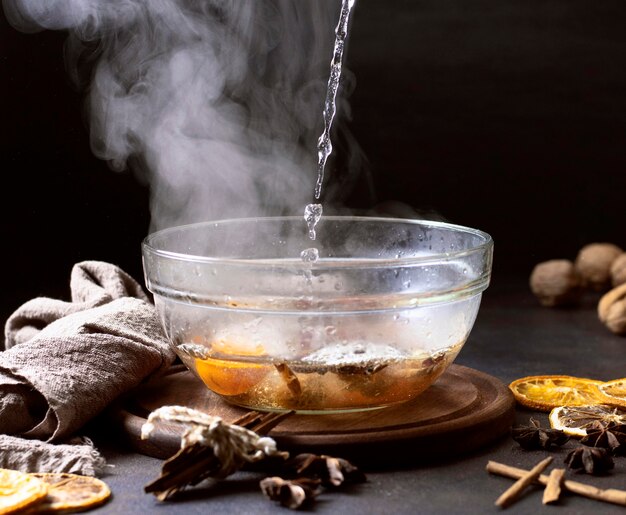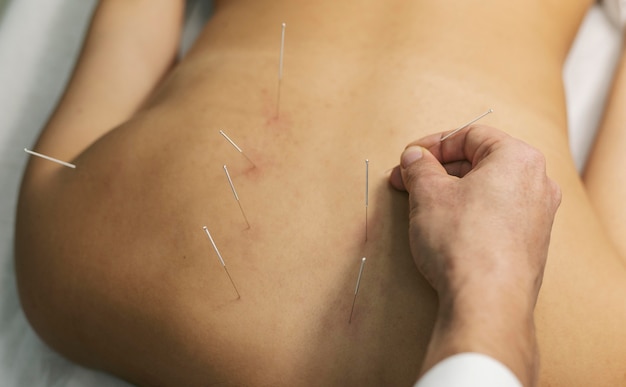
For the past few months, I've started every day the same way – with a large tablespoon of a foul-tasting golden-colored gel. The best way to describe its texture is lumpy Vaseline, and the acrid chemical aftertaste is so severe the only thing that can get rid of it is a strong black coffee. It might sound like a snake-oil medical treatment from the 1800s, but it is a £17 health supplement made with moss harvested from the shores of the Caribbean island of Saint Lucia. And while this gel, known as sea moss, will not win any awards for its flavor, I believe it has changed my life. Since I began taking it every morning, I've experienced what can only be described as an entire personality change.
Our reporter Dolly Busby put sea moss, which is becoming increasingly popular with Gen Z, to the test US supermodel Bella Hadid swears by the benefits of sea moss and claims to drink a glass of it every morning Suddenly I have boundless energy and no longer yawning at 5 pm. My friends have commented on how well I look, with some even describing my skin as glowing. I've also stopped getting hangovers. I'm far from the only sea moss zealot. Over the past two years, it has exploded in popularity among women under 25 – Gen Zs. There are more than 1.4 million sea moss posts on Instagram, including gushing promotions from famous influencers. It is essentially billed as the ultimate vitamin supplement. However, sea moss also has a dark side, with reports of users falling seriously unwell.
Sea moss is a type of algae that looks somewhat like seaweed and grows in tide pools. There are several types, the two most common being Irish and Caribbean moss.
Records show it was used as a medicine as far back as 600 BC when the Chinese harvested it to treat respiratory illnesses.
During the Irish potato famine in the 19th Century, sea moss was eaten to combat starvation. But in recent years, companies have begun to turn it into a gel that can be kept in a jar and stays fresh for several months.
These gels, which come in a variety of bright colors, have risen in popularity in part due to endorsements by celebrities such as reality TV star Kim Kardashian, who says she drinks sea moss smoothies.
US supermodel Bella Hadid claims to drink a glass of sea moss every morning.
As a showbusiness reporter for the Mail, I closely follow the lives of top celebrities and, after watching these influential women sing its praises, I thought I'd give it a try. I even went for the same brand as Bella – Planted Seeds Gold Sea Moss Gel.
Planted Seeds Gold Sea Moss Gel The main draw is that it is supposed to be packed with minerals.
According to Island Moss, one of the UK's largest suppliers, a spoonful contains magnesium, potassium, iodine, sulfur, calcium, selenium, fiber, copper, phosphorus, zinc, riboflavin, and manganese.
The firm says these 'supply energy, regulate digestion and detoxify the body'. I'm 24 and I eat a fairly healthy diet. But while I don't know what many of these minerals do, it's an appealing promise. However, some experts have voiced concerns about the safety of sea moss, warning that excessive consumption can lead to thyroid issues due to high levels of iodine.
A small gland in the neck that produces important hormones – too much can leave it overactive, leading to symptoms such as mood swings, fatigue, and difficulty sleeping. Earlier this year, a 28-year-old woman in Connecticut in the US was hospitalized with severe thyroid disease after taking sea moss 'sporadically' for a month. Dr Duane Mellor, a dietician at Aston University in Birmingham, said: 'If someone has an overactive thyroid, then too much iodine can be an issue. 'Normally most people struggle to consume enough iodine, but sea moss has a lot of it.' Experts also question whether sea moss can be healthier than multivitamins, which are carefully formulated to contain a good balance of nutrients. 'Sea moss is without question rich in vitamins and minerals, but it's unlikely to be a superior replacement for a good multivitamin,' says Harley Street nutritionist Kim Pearson. 'Sea moss is naturally occurring so the chances that it will contain the same efficient health boost is low.' As for me, I'm thinking of giving up the sea moss. The energy boost I initially got from it has slowly faded. My theory is that when I first started taking the gel, my body suddenly got nutrients it didn't have before. But now that's gone, I'm not sure I want to keep eating a repulsive – and surprisingly expensive – gel every morning.
Algae that makes you 'glow from the inside out' explained We're taking a look at the rise and rise of sea moss with the help of experts. So can this 'miracle', nutrient-rich ingredient help you to glow from the inside out, or is it just another TikTok-born fad?

You always have to be a little wary about skincare and health trends born in TikTok, but sometimes, yes, a craze does start that goes on to help thousands of people who would have otherwise been in the dark about a particular product or health hack. If you need an example, look at sea moss.
This trending alga is everywhere on the video app at the moment, with 230k clips under the hashtag #couponzatps. It also helps that celebrities like Bella Hadid and Kim Kardashian tout it as their 'secret' weapon to glowing skin and boosted energy. Bella is so on board with the ingredient that she recently shared that she drinks a glass of it every morning. You'd be completely forgiven for never having heard of sea moss before now because the trend seems to have popped up out of nowhere. The ingredient, however, isn't new at all. Vegans will have come across it thanks to its egg-like thickening abilities. Going much further back than that, it was said to have been a staple food for Ireland’s working class in the mid-1800s when the country was experiencing a potato famine, and then later introduced by Irish immigrants to other countries like Jamaica, where it became a relatively common addition to foods like ice cream and soups.
Dr Kajal Babamiri, GP specialist in dermatology at CLNQ Clinic, explains: "Nutritionally, sea moss is quite impressive. It contains 92 of the 102 minerals that the human body needs, including iodine, calcium, potassium, magnesium, and sulfur. It's also rich in vitamins A, E, F, and K, alongside omega-3 fatty acids, antioxidants, and amino acids. These nutrients contribute to its reputation for promoting overall health. " She continues: "It's also thought to improve thyroid function due to its iodine content, enhance digestive health through its prebiotic fibers, and boost immunity with its high antioxidant levels. Additionally, its anti-inflammatory properties can aid in reducing inflammation and potentially alleviating conditions like arthritis.
These kinds of claims are mostly being made by social media influencers," Dr Babamiri explains. "This idea is rooted in its nutritional profile, which supports skin health. The vitamins and minerals found in sea moss can contribute to collagen production, potentially improving skin elasticity and hydration. Antioxidants combat free radicals, reducing signs of aging and promoting a clearer complexion. Therefore, regular consumption of sea moss might result in healthier, more radiant skin, lending some credence to the glowing testimonials seen online.
Yes, for those looking to boost their general wellness, but manage your expectations. "While there are genuine health benefits associated with its nutrients, the notion that it is a miracle cure or an essential supplement for everyone is an exaggeration.
Like any supplement, sea moss should be consumed in moderation. Overconsumption, particularly of iodine, can lead to thyroid issues. It is always best to consult with a healthcare provider before adding a new supplement to your diet, especially if you have existing health conditions or are on medication," Dr Babamiri concludes. How do I take sea moss? It comes in gel, capsules, and gummy forms. Many users like to add it to their smoothies like they would a protein powder, while others prefer to swallow it whole as a tablet. There's also the 'influencer' method where the gel is taken straight from a tablespoon. Though sea moss doesn't have. a taste, some note the gel-like texture of certain products makes it unpalatable to swallow neat. Best sea moss to shop in the UK.

wildcrafted sea moss, spring water, and lime – making it a great choice for anyone looking to reap the full benefits of the algae. Once opened, you'll need to use it within three weeks. However, if you're taking 1-2 tablespoons each day, as recommended, this shouldn't be an issue. These seaweed superfood capsules are packed with essential nutrients for gut health and glowing skin. The brand recommends taking 1-2 capsules daily after your morning and evening meal, and to keep them fresh, store them at room temperature in a cool, dry place. Freshly made to order, this can be kept in the refrigerator to be used within 3 weeks. Alternatively. it can be frozen for up to 6 months. Wildcrafted and not pool grown, the sea moss in this is sourced from a natural mineral-rich marine protected area in Grenada. Gummies aren't usually as nutritionally packed as gels and liquids, but these contain a respectable 350mg 10:1 sea moss extract, and contain added vitamin C as well as 100% of your daily vitamin D intake to support your immune system.
If you can't stomach the more dense gels, these could be for you.
03 Cupping Therapy and Its Benefits Cupping therapy is an ancient form of alternative medicine where a therapist puts special cups on your skin for a few minutes to create suction. The idea is to draw blood to or away from parts of your body. People get it for many reasons, such as pain and inflammation relief, relaxation and well-being, and as a type of deep-tissue massage. Cupping therapy is putting suction cups on your back to help with pain, inflammation, and other health problems.

Earthenware Silicone Plastic History of cupping therapy might be trendy now, but it’s not new. It dates back to ancient Egyptian, Chinese, and Middle Eastern cultures. One of the oldest medical textbooks in the world, the Ebers Papyrus from 1550 B.C., describes how the ancient Egyptians used cupping therapy for treating fever, pain, vertigo, menstrual problems, and other ailments. The Egyptians introduced cupping to the ancient Greeks who used it as a cure for almost every illness.
In traditional Chinese medicine, it's closely linked to acupuncture. The Islamic Prophet Muhammad also recommended cupping in his writings, where he called it hijama. Originally, hollowed-out animal horns were used to treat boils and suck out venom from snake bites.
Eventually, horns were replaced by bamboo and then by glass cups. Cupping was used widely in Europe and America until the 1800s when it fell out of favor as the practice of medicine became more scientific and focused on treating illnesses from the inside out. People in several countries still practice cupping. Many Americans first became aware of it after seeing purplish circles on the body of swimmer Michael Phelps during the 2016 Olympics.
For either type, in the traditional method (fire cupping), your healer puts a flammable substance such as alcohol, herbs, or paper, inside a cup and sets it on fire. As the fire goes out, they put the cup upside down on your skin. When the air inside the cup cools, it creates a vacuum. This causes your skin to rise and redden as your blood vessels expand.


The therapist just applies the cups to your skin, compressing them with their hands, a pump, or a flame if using glass cups. (They may apply lotion first). They leave the cups in place for 5-10 minutes. You can have this therapy done as often as once or twice a week. Dry cupping may be combined with a massage.
This is called massage cupping or running cupping. Your therapist puts lotion or oil on your skin and moves silicone cups back and forth, up and down, or in circles on your skin for a massage-like effect. Dry cupping is meant to increase blood flow while removing fluids and toxins from the area being treated. The fluids are said to have high levels of substances related to diseases. Wet cupping therapy In wet cupping, your therapist first creates a mild suction by leaving a cup on your back for about 3 minutes. They remove the cup and use a small scalpel to make light, tiny cuts on your skin. Next, they do a second suction to draw out a small quantity of blood.
They might leave those cups in place for 10-15 minutes. The idea is the cuts attract inflammatory cells and cause the release of natural pain relievers and mood enhancers called endogenous opioids. These help your body fight infections and maintain immunity. You might get three to five cups in your first session. Or you might just try one to see how it goes. It’s rare to get more than five to seven cups, the British Cupping Society notes.
After treatment, you'll get an antibiotic ointment and bandage to prevent infection. Your skin should look normal again within 10 days. You can repeat wet cupping every 4-8 weeks. Wet cupping can also be done in a two-step version where your therapist doesn't start with suction but first makes cuts in the skin and then applies the suction cups. It's not exactly clear how cupping works to ease pain and cure diseases, though there are several theories. There haven’t been many scientific studies on cupping. One report, published in 2015 in the Journal of Traditional and Complementary Medicine, notes that it could help with acne, herpes zoster, and pain management. However, the researchers said many of the studies they reviewed could have been biased and that better studies were needed.

The National Center for Complementary and Integrative Health says there's not enough high-quality research to determine whether cupping can be used for all these conditions. Cupping for pain management The "pain-gate" theory says that the touch and pressure from cupping stimulate large nerve fibers, which results in the blocking of pain signals to the brain sent by other nerves. The gate control system is in our spinal cords. So, activating these nerve fibers can block pain transmission.
One 2023 review of existing studies found that cupping seemed effective for managing chronic pain, knee osteoarthritis, low back pain, neck pain, chronic back pain, and herpes zoster. However, the studies were all of low to moderate quality. In general, experts see cupping as something that should complement conventional medicine rather than replace it. Cupping for acne In the immune system theory, cupping can reduce inflammatory substances and increase the production of substances to improve your immune system. Cupping may also boost your body's antioxidant processes. So, cupping might be able to help with skin conditions. One Iranian study compared two groups of people. One got acne medicine along with wet cupping, while the other got acne medicine and "sham cupping" (a device that felt like real cupping but had a tiny hole). The group that got the medicine and the wet cupping showed more improvement than the control group.

where the therapist first inserts acupuncture needles and then puts cups over them. The idea is that the cupping loosens muscles while the needles relieve the pain. One study showed that ear acupuncture combined with cupping therapy was more effective in treating chronic back pain than treatment using only ear acupuncture. Cupping is fairly safe, as long as you go to a trained professional. But you could have the following side effects in the area(s) where the cups touch your skin: Mild discomfort Burns Bruises Skin infection If the cups and equipment become contaminated with blood and aren't sterilized correctly between patients, bloodborne diseases such as hepatitis B and C can be spread. Burns from cupping Burns from fire cupping are a hazard but seem to be rare. Overheating the cup is usually the problem. An Australian study looked at 18,703 patients enrolled in the Burns Registry of Australia and New Zealand over 7 years and found just 20 had cupping-associated burn injuries. Sixteen of these occurred at home. Still, more people could have been burned but not badly enough to go to a hospital. There have been some other reports of people getting burned at cupping clinics. Marks from cupping Cupping marks are a common side effect of applying suction cups to your skin. They're usually circular and can range in color from light pink to dark purple, depending on your skin tone and how much pressure was used to apply the cups. These usually fade over time, in about 1-10 days. If you have to go to your doctor before the bruises have healed, let them know that the marks aren't due to physical abuse.
There's no conclusive evidence, but some believe it's a risk. Experts warn to avoid cupping if your skin is scraped, oozing, or infected, as this can increase the chance of blood clotting. Also, if you're on a blood thinner or have heart disease, you shouldn't do cupping therapy. You can have cupping on any part of your skin where suction cups can be applied. The most common areas are the: These all have a lot of muscle. Less common areas include the chin, the crown of the head, thighs, neck, and shoulders. Cupping therapy for shoulders Cupping could be good for shoulder pain, as it increases circulation in the pain area (which encourages healing) and reduces muscle tension. But there aren't definitive studies that say cupping reduces shoulder pain. Benefits of cupping therapy on back Back pain is a popular reason why people seek out cupping.
cupping increases blood circulation and reduces muscle tension. Some studies do show it can reduce back pain, but they aren't conclusive. Benefits of cupping on knees Cupping may reduce knee inflammation by increasing blood flow and flexibility. It also encourages tissue repair. One study said cupping for knee osteoarthritis was as effective as taking 650 milligrams of acetaminophen three times a day. However other studies showed weak evidence. Many people may offer cupping therapy, including Massage therapists Acupuncturists Physical therapists Chiropractors Occupational Therapists Doctors You're most likely to get cupping from a massage therapist or an acupuncturist. They don't need to have special certification to offer cupping therapy, but they often have it. They usually need to be a licensed massage therapist or acupuncturist to offer any services. Requirements depend on the state you live in.
Make sure that your provider/therapist is cleaning and sterilizing the equipment they use between sessions, or using disposable cups and blades. Cost of cupping therapy Costs run about $30-$100 per session, depending on where you live and how long your session lasts. It could be as short as 15 minutes or as long as 1 hour. Also, wet cupping will cost more than the dry type. Some places offer a discount if you buy a package of appointments. Cupping therapy at home Yes, you can give yourself cupping therapy. Many kits are available containing plastic, silicone, or glass cups. Please do not buy glass cups, as these need to be heated to be applied and are too dangerous for beginners to use. Stick with plastic or silicone. Plastic ones usually come with a pump. Silicone cups are for doing massage cupping, which involves moving the cups around. You can learn how to use cups by reading books, watching videos, or following instructions online. Let your doctor know you intend to try this therapy, as you might have a health problem that could make cupping a bad idea. Talk with your doctor before you start cupping or any other type of complementary medicine.
Cancer Organ failure Hemophilia or other blood clotting disease A pacemaker Cardiovascular disease High cholesterol An infection You should also avoid cupping if you're pregnant, menstruating, elderly, under 18, or taking a blood thinner.
Cupping is an ancient therapy that's now back in style. It aims to increase blood flow, soften scar tissue, and decrease muscle pain by placing suction cups on your body and leaving them on for 10-15 minutes.
Practitioners say it can help with back pain, arthritis, depression, migraines, acne, and many other conditions.
Not many scientific studies support these claims, but some people who've had cupping therapy done swear by it.
Some studies say that cupping helps with pain relief, but most of the studies were not high-quality.
Scientists aren't exactly sure how cupping works, so more research is needed. Cupping has minor side effects, so trying it usually won't hurt.
Just let your doctor know you want to do it. And don't stop your normal treatment unless your doctor says it's OK.
After a cupping session, you'll probably see round red marks on your skin, which should fade in a week or two. Your therapist may advise you to drink lots of water (to flush out toxins), stay warm, and rest. You may feel a little tired as if you're fighting a minor illness. Therapists say this is normal, a side effect of your body getting rid of toxins.